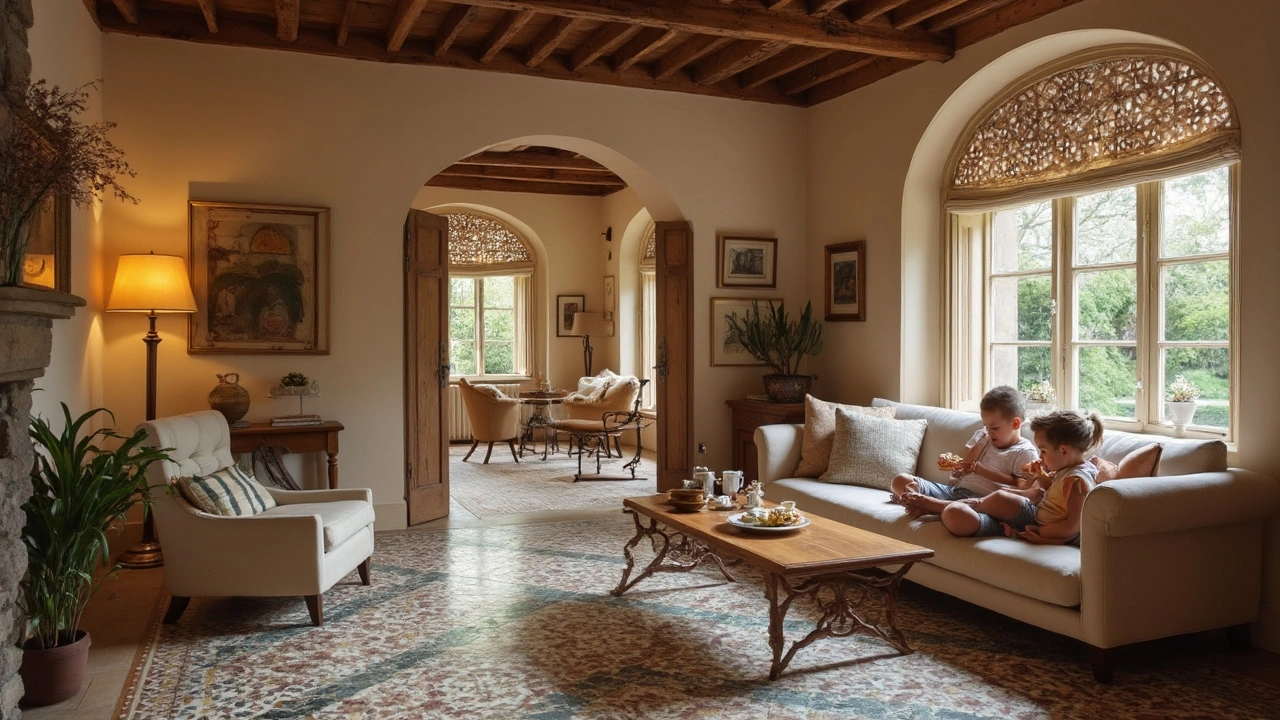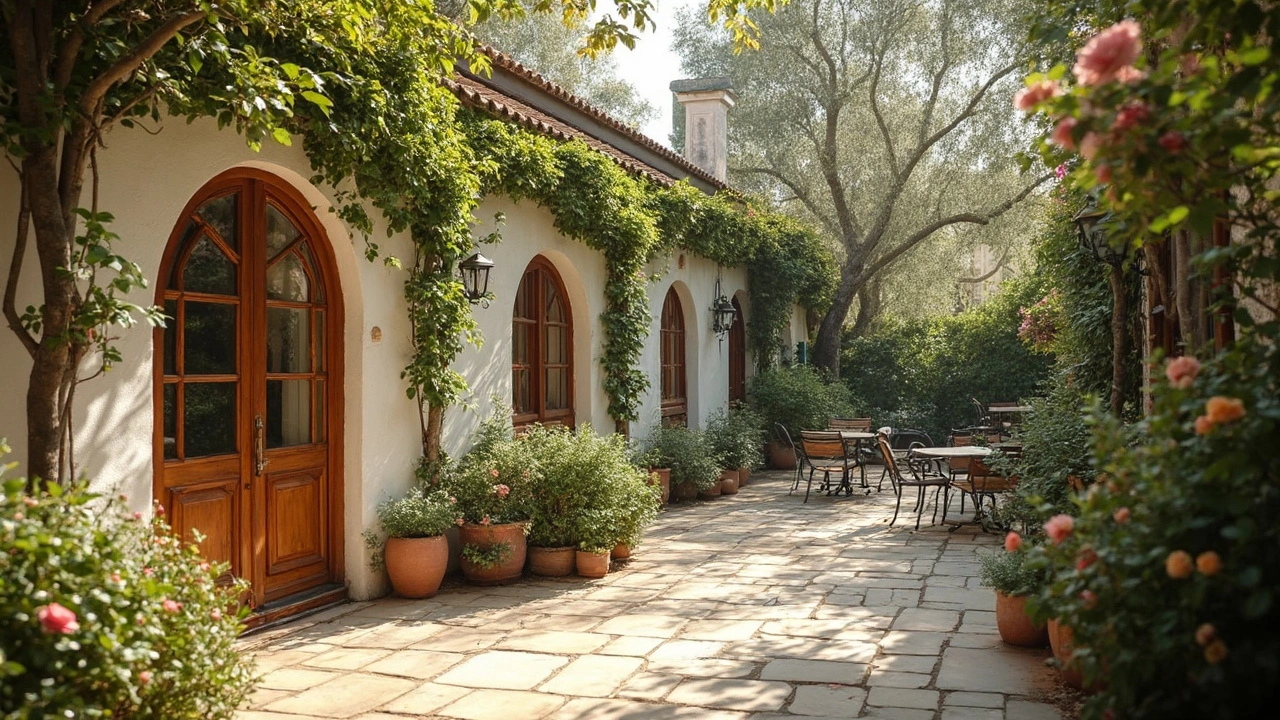Ever walked past a home with a red tile roof, arched windows, and heavy wood doors and felt like you’d been whisked to the coast of Spain or Italy? That’s the magic of Mediterranean Revival architecture. This style isn’t just about looks—it’s a blueprint for relaxed, welcoming living that actually makes life better for people who use it every day.
If you’re hunting for ways to bring character to your place, you don’t have to buy a mansion or live in southern California. Mediterranean touches work just as well in city apartments and cozy suburban homes. Think about adding a curved entryway, warm stucco walls, or simple iron details. Even swapping out your basic windows for something arched or adding potted olive trees to your balcony can make a big difference.
- Where Mediterranean Revival Began
- Key Features You Can Still Use
- Why This Style Stays Popular
- Making Mediterranean Work in Today’s Homes
- Common Mistakes to Dodge
- Real-Life Examples and Inspiration
Where Mediterranean Revival Began
Mediterranean Revival architecture didn’t just pop up out of nowhere. It took shape in the United States in the early 20th century, especially during the 1920s and 1930s. You can thank places like Florida and Southern California for putting it on the map. These regions wanted homes that could handle hot, sunny weather while looking amazing—so designers started borrowing ideas straight from the palaces, villas, and seaside resorts along the Mediterranean coast.
The style has roots stretching back to countries like Spain, Italy, and even Morocco. Architects cherry-picked the best bits from Spanish Renaissance, Italian Renaissance, and Moorish influences. That’s why you see all those distinct features—tile roofs, arched doorways, big courtyards, and hand-painted tiles.
One of the first hotspots for this look was Coral Gables, a planned community near Miami. The city’s founder, George Merrick, pretty much made mediterranean revival the official style for most buildings there in the 1920s. Famous architects like Addison Mizner in Palm Beach became legends for their over-the-top Mediterranean mansions and hotels. In California, the style spread like wildfire after events like the 1915 Panama-California Exposition in San Diego, which showed off Spanish Colonial-inspired designs to thousands of visitors.
Here’s a quick peek at where and when Mediterranean Revival made its biggest mark:
| Location | Key Dates | Famous Examples |
|---|---|---|
| Coral Gables, Florida | 1920s | Biltmore Hotel, Venetian Pool |
| Palm Beach, Florida | 1920s-1930s | El Mirasol Estate, Everglades Club |
| Los Angeles, California | 1920s | Adamson House, Oviatt Building |
| Santa Barbara, California | 1920s | Santa Barbara County Courthouse |
Because the Mediterranean basin itself includes so many cultures, the style isn’t a copy of any single country’s look—it’s a mashup, and that’s what keeps it interesting. It started as a clever solution for climate and curb appeal, but thanks to passionate builders and a bit of show-off spirit, it became a classic American style almost overnight.
Key Features You Can Still Use
Don’t get stuck thinking Mediterranean Revival is out of reach for your home. A lot of the good stuff that makes this style special can fit into places big or small. What most people love? It’s the mix of simple materials and thoughtful details. Clay roof tiles, for example, aren’t just for looks—they actually help keep homes cool in hot weather. Same goes for those thick stucco walls that keep the AC costs way lower during scorching summers.
Let’s get specific. Here’s what you can steal from this style and make your own:
- Mediterranean Revival arches: These aren’t just dramatic—they’re practical, making small spaces feel open and letting in more sunlight. Try an arched doorway or even a budget-friendly arched mirror for instant impact.
- Natural materials: Go for terracotta tiles on the floor, wood beams on the ceiling, or stone accents around the fireplace. These last longer than cheap alternatives and never really go out of style.
- Wrought iron touches: From stair rails to light fixtures, black iron pops against warm plaster and adds both strength and character.
- Courtyards and patios: If you’ve got outdoor space, even a tiny one, turn it into a chill hangout with clay pots, low benches, and leafy plants. This is where people really feel connected—whether it's coffee in the morning or dinner with friends.
- Earthy color palettes: Think sandy tones, warm whites, deep blues, and olive greens. Even just painting your front door a bold, sunbaked red can give a nod to Mediterranean style without a full renovation.
Architectural historian Richard Guy Wilson once said,
“Mediterranean Revival endures because it’s rooted in lifestyle first—spaces for gathering, features for climate, and always a feeling of easy welcome.”
Little changes make a big difference. Swap boring metal window grilles for something with a swirl, hang a simple lantern-style porch light, or trade basic house numbers for classic tiles. You don’t need a huge budget to land that breezy, vacation vibe right where you live.
Why This Style Stays Popular
So, why won’t the world get over Mediterranean Revival? It nails the sweet spot between laid-back comfort and solid craftsmanship. These homes look good and work even better, especially in sunny places. That’s why you see them not just in old neighborhoods around Miami and LA, but in new builds across the U.S. They’re designed to keep things cool with thick walls, deep eaves, and shaded outdoor spaces. Anyone who hates high AC bills gets the appeal right away.
There’s also the vibe—this style makes people feel like every day is a holiday. You get open courtyards, lots of light, and that life-is-meant-to-be-enjoyed energy. On top of that, these details—arched doors, colorful tiles, hand-wrought iron railings—have just enough flair to stand out, but they never feel try-hard or dated. The look is timeless for a reason.
Mediterranean revival keeps its edge because people want homes that are durable and simple to maintain, but still have personality. Here are some stats that show its staying power:
| Stat | What It Means |
|---|---|
| 70% of buyers in coastal regions look for weather-friendly exteriors | Stucco, clay tile, and shaded patios win big |
| 30% more resale value in neighborhoods with Mediterranean elements | Classic features boost home prices |
| 82% of homeowners in Florida say outdoor living space is a top priority | This style’s courtyards and verandas deliver |
One more thing: with all the trends that come and go, Mediterranean homes still pop up everywhere from Pinterest boards to high-end real estate listings. That’s proof people love what’s practical, classic, and just a little bit romantic—without the fuss.

Making Mediterranean Work in Today’s Homes
You don’t need a villa or sweeping acres to bring that sunny Mediterranean Revival vibe into your space. Plenty of folks today borrow elements from the classics and use them in reasonable, budget-friendly ways. In fact, a 2024 Houzz survey found that nearly 18% of remodelers picked some Mediterranean touches for their kitchen or outdoor spaces—especially in places like Florida, Texas, and California where the weather totally fits the style. But honestly, you can make it work almost anywhere.
First, focus on simple, high-impact changes. Swap out standard flat doors for arched openings or doors with wrought iron accents. Use affordable, earthy materials—think terracotta tiles for a kitchen floor or even just planters for the balcony. White or pale stucco paint brings that sun-washed feel to any wall, inside or out.
| Mediterranean Feature | Cost Estimate ($) | Impact Level |
|---|---|---|
| Arched Interior Doorway | 500–1,500 | High |
| Terracotta Patio Tiles | 1,200–3,000 (200 sqft) | High |
| Wrought Iron Light Fixtures | 100–450 each | Medium |
| Stucco Exterior Paint | 2–6 per sqft | High |
| Ceramic Pots with Olive Trees | 40–150 each | Low |
If you’re going for authenticity, stick with nature-inspired colors—think warm whites, dusty ochres, and soft blues or greens. Add texture through plaster, wood beams, or even clay lamps. The idea is simple: balance comfort with visual interest. Remember, Mediterranean homes are all about hanging out and making people feel at ease, not tiptoeing across a showroom floor.
One cool tip: mix old with new. A slick modern kitchen can totally fit, as long as you tie in a few Mediterranean details—maybe a mosaic backsplash, rustic hardware, or an arched range hood. The mix keeps things fresh instead of feeling like a museum.
“Mediterranean Revival isn’t just a style. It’s a way to design for real life—spaces that actually get used, that feel lived in. Don’t stress about being perfect. Go with what feels welcoming.”
— Christina Valencia, interior designer and host of HGTV’s "Mash-Up Our Home"
Lastly, outdoor living is huge for this vibe. Even a tiny balcony or backyard can get the look: string up some bistro lights, add a few glazed pots, toss in a weatherproof rug, and you’re there. No need to go overboard—the point is to keep it inviting, laid-back, and personal. That’s the heart of mediterranean revival design.
Common Mistakes to Dodge
It’s really easy to mess up a mediterranean revival look if you don’t pay attention to the basics. The main thing that trips people up is going overboard—loading too many elements into a small space, mixing styles that just don’t vibe, or picking the wrong kind of materials because they look roughly close.
The folks at Architectural Digest warn,
“A successful Mediterranean Revival project is about balance and honest materials, not just tacking on a red roof or throwing a few tiles around.”
Here are the top mistakes people run into—and how to steer clear of them:
- Fake Stone and Low-Quality Stucco: Real Mediterranean homes use solid, natural materials. Skip the plastic stone panels and rough, bumpy stucco. They weather badly and look cheap fast.
- Ignoring Proportion: Huge archways, too-big beams, or chunky trim in a small apartment? It just looks cartoonish. Scale things down and use details that fit your space.
- Overcrowding with Decor: If you jam in too many painted tiles, wrought iron pieces, and ornate lighting together, things get cluttered fast. Pick two or three key features to highlight.
- Neglecting Function: Don't force outside elements (like thick clay roof tiles) in places with tons of snow. That’s just asking for trouble with leaks and costs.
- Mismatched Colors: Mediterranean palettes are earthy: terracotta, olive green, crisp whites, and mellow blues. Neon or super dark colors throw the whole thing off.
See how homes with Mediterranean Revival touches stack up compared to other styles when it comes to resale value and owner satisfaction:
| Style | Avg. Resale Value Increase (2024) | Owner Satisfaction (%) |
|---|---|---|
| Mediterranean Revival | +12% | 88 |
| Colonial | +8% | 73 |
| Modern Farmhouse | +9% | 78 |
Bottom line: focus on quality over quantity with Mediterranean design. A little goes a long way, so choose a few details that really fit your home—and skip the shortcuts with cheap materials or clashing colors.
Real-Life Examples and Inspiration
Want proof that Mediterranean Revival isn’t just for the history books? Head to Coral Gables, Florida. The city was pretty much built on this style back in the 1920s. Tourists today still flock to spots like the Biltmore Hotel, a grand building loaded with columns, stucco, and signature clay tile roofs. You’ll also see smaller homes in the neighborhood echoing the same vibes, but on a scale most people can actually picture for themselves.
Los Angeles and Santa Barbara have their fair share of Mediterranean gems too. The Adamson House in Malibu is a fun one—go there and check out its vibrant tiles and ocean-facing patios. Even in cities with a colder or wetter climate, folks borrow ideas like sheltered courtyards and decorative iron railings without trying to clone every detail. This makes it easy to pick features that actually fit your lifestyle.
If you want inspiration that feels closer to home, here are a few practical ways people are nailing the look today:
- A couple in Austin replaced boring drywall with exposed wooden beams and textured plaster walls. The look feels fresh but totally classic.
- A small Chicago townhouse ditched its vinyl siding for terracotta-colored stucco and swapped out builder-grade lamps for chunky bronze sconces from a local salvage yard.
- Newer condos use arched niches indoors—not just as windows, but as bookshelves or alcoves for plants and art.
Small changes can create a big impact. Here’s a quick table that shows which Mediterranean Revival features are most popular in different regions of the US:
| Region | Common Features | Favorite Color Schemes |
|---|---|---|
| Florida | Clay tile roofs, arched entryways, palm-filled courtyards | Warm whites, coral, seafoam green |
| California | Exposed beams, wrought iron details, patterned tiles | Earthy tans, bright blue, terra cotta |
| Southwest | Stucco exteriors, shaded patios, iron lanterns | Sun-bleached yellows, rust, olive green |
If you’re after that mediterranean revival feeling, don’t feel boxed in by tradition. Mix the classic bits with what you already love. Modern kitchens with glossy cabinets can still work with Saltillo tile floors. Outdoor spaces can feel “Mediterranean” with nothing more than a small tiled fountain and a few pots of lavender. The real trick is focusing on a few strong details—not overdoing it. Take a walk around your neighborhood or browse real estate sites for houses that mix the old with the new. You’ll find tons of fresh ideas worth trying.





